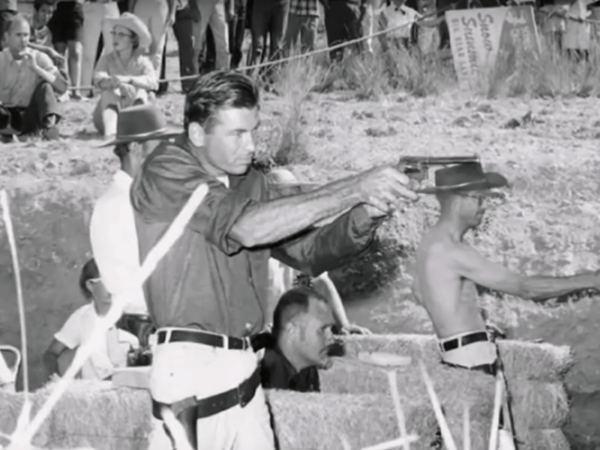Is Anyone Still Using the Weaver Stance?
My shooting stance got the job done, but it still earned the rod of correction from an instructor. "Pull your weak-side arm in a little. Elbow pointing down now. Flex the strong side arm a little. There."
Noticing the pained expression on my face as I tried to aim using the position demanded, my teacher laughed. "Yeah, the Weaver kind of sucks, doesn't it?" she said, shaking her head as she turned to attend to another student.
In turning so abruptly, she missed my arched eyebrow.
The class was the Massad Ayoob Group's MAG-20 Range course, offered by NG Investigations in Ocala, Florida (review forthcoming.) It definitely was not Gunsite Academy, the originator of the Modern Technique of the Pistol, a big part of which was the Weaver Stance; strong side foot in the back, knees unlocked, bladed torso, weak arm bent sharply downward, strong arm straight but with unlocked elbow, isometric push-pull grip on the pistol.
It was also a place where I'd spent a week during Obama's first term, taking their fundamental fighting course, Pistol 250. Certainly I should know what I'm doing when it came to a Weaver stance, right? But it wasn't ego that prompted the raised eyebrow, it was the fact that I'd received almost the same corrective during my Gunsite training.
Apparently, a week in the desert hadn't changed the fact that I still wanted to have my strong arm locked -- a modified Weaver at best, or a "Chapman" stance, as Ayoob preferred to call it, after the late teacher and competitive shooter.
This off-the-cuff correction from the Florida trainer started me on the road to a small epiphany -- one which a smarter and more self-aware shooter would've reached much earlier.
Up to this point, I'd had over 150 hours of instruction on gun fighting, but all of it had come either at Gunsite itself, or schools founded by veterans of the academy and professors of the Modern Technique (some going back to "Orange Gunsite".)
I'm far from being an operational operator, of course, but I'm also not at the back of the pack when it comes to shooting fundamentals. Still, I hadn't questioned the Weaver stance -- even though I clearly fell out of it and into a more "modified" stance when I didn't have an instructor breathing down my neck.
Also, it wasn't clear to me that my shooting suffered significantly when this happened. Quite the opposite; like a self-conscious golf player, when I start worrying about stance, the worse I perform. When I simply stay in the moment...good things happen.
So it's time for me to revisit the issue. When I returned to Motown, I started thinking a bit more about stances and talking to people who'd been there, done that.
Massad Ayoob's namesake school teaches Weaver, Chapman, and the Isosceles stances to its students, but clearly prefers Isosceles as a general default stance. The Weaver, Mas writes his 1984 book, Stressfire,
...tends to fall apart under extreme stress. With those conditions prevailing, the essential boxer's stance cannot always be achieved. Without moving the feet, one finds the ability to traverse is extremely limited -- to 90 degrees or even less for some people.
Under stress, with exaggerated gross strength movement and loss of coordination, the strong arm tends to overpower the weak arm, sending the Weaver shooter's bullets high left if he's right handed. The exaggerated push-pull of the technique also increases muscle tremor.
Raising of the weak elbow allows greater traverse but unlocks the hold, reducing accuracy for most people. Finally, the sharply edgeways stance exposes an armored-officer's unprotected whole or upper side to the opposing gunfire.
(And, as one of my fellow MAG-20 students--also a firearms instructor--observed: a hit to a bladed torso is more likely to cause a fight-stopping injury against you than a single hit to a full frontal chest, simply because more organs are lined up for the round to strike.)
Mas isn't the only one who is skeptical of Weaver. He's joined in that by the famous (infamous?) Gabe Suarez.
In 2004 or 2005 we had a Force On Force class...the first one, in Las Vegas. I set guys up facing each other at five yards. Armed with Airsoft pistol analogs to their real weapons, and suitably protected with face masks, I told them to "GO". This simulated a true gunfight to a far greater degree than any range exercise these men had ever seen before.
We had extremely accomplished Modern Technique guys totally change their perspectives on gunfighting [afterward]. We had "Combat Masters" from Taylor's and Front Sight get their asses handed to them by first time attendees, school teachers, doctors, and students who understood what we were teaching....
[I]n proactive shooting there is no need for the dynamics of the Weaver stance with a moderately developed upper body and hand strength. All one has to do is look at what the world's champion shooters use and you will not find Weaver stances there.
Often times what is needed is simply getting the weapon out quickly and punching it forward, working the trigger as you do so. Watch a force on force event and you will not see any Weaver or isosceles stances. You will see a great deal of one handed shooting.
If that wasn't enough, the celebrated competition shooter (and fellow Louisianan,) Jerry Miculek agrees.
https://www.youtube.com/watch?v=ChSazF41q-s
Jerry says:
I shoot a basic Isosceles stance, pretty much square to the target... If I was going to shoot a Weaver stance -- which we all did back in the day when we didn't know anything -- you pretty much have to blade into the target. Push with this hand, pull with that hand [the isometric grip.]
They were trying to get more control over the handgun, but they went about it the wrong way. The thing about opposing forces, it sounds really good until you screw it up. So if you have a little bit less technique pushing and pulling, you get weird oscillations on the front sight, and it's not repeatable.... It's not worthy of your time.
When I learn that Mas, Gabe, and Jerry are on the same page about anything related to shooting, I pay close attention, even if it's for different reasons.
Seeking counsel, I spoke with a friend from Georgia who's done far more firearms training in and out of uniform than me. Stance is important when learning the fundamentals, he said. Afterward, "you proceed to point shooting and getting off the X." He suggested I continue my education...with Suarez, whose classes he endorsed.
Sure, I've criticized some of the things Suarez has said in the past, but I just might take him up on that suggestion. The reason is simple: I've let myself get in a comfort zone when it comes to training. It's time to shake things up. And say what you will about him, Suarez knows a thing or two about gunfighting.
Am I trashing Gunsite, the Weaver or the Modern Technique here?
Far from it. It was a fantastic place to start, and whatever skill I have in shooting and gunfighting I owe to its originators and instructors. I don't, however, learn form for form's sake, but rather to an end, and here that end is: winning a gunfight which can't otherwise be avoided.
I still have much to learn, after all. And it's time for me to get out of the comfort zone. It's time to try trainers from different schools, whether it's Suarez, Ayoob, or someone else.
[Hat tip: Zachomega @ PAFOA.org, whose question, "When did the Weaver stance die?" started me on this path.]



